<< Previous | Displaying results 651-700 of 6773 for "" | Next >>
An estimated 197,464 prisoners passed through the Mauthausen concentration camp system between August 1938 and May 1945. At least 95,000 people were killed there.
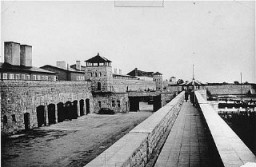
An estimated 197,464 prisoners passed through the Mauthausen concentration camp system between August 1938 and May 1945. At least 95,000 people were killed there.

An estimated 197,464 prisoners passed through the Mauthausen concentration camp system between August 1938 and May 1945. At least 95,000 people were killed there.

Located 22 miles east of Danzig, Stutthof began as a civilian internment camp under the Danzig police chief and later became a "labor education" camp under the German Security Police. In January 1942, Stutthof became a regular concentration camp....
Stutthof began as a civilian internment camp under the Danzig police chief and then became a "labor education" camp under the German Security Police. In January 1942, Stutthof became a regular concentration camp. Stutthof prisoners were used as fo...
The Ravensbrück concentration camp was the largest concentration camp for women in the German Reich. The SS required Ravensbrück prisoners to perform forced labor. Starting in the summer of 1942, prisoners were also subjected to unethical medical...
The Ravensbrück concentration camp was the largest concentration camp for women in the German Reich.
The Ravensbrück concentration camp was the largest concentration camp for women in the German Reich. The SS required Ravensbrück prisoners to perform forced labor. Starting in the summer of 1942, prisoners were also...
Between 1943 and 1945, a group of Jewish men and women from Palestine parachuted into German-occupied Europe. The 32 parachutists had volunteered with the British army and were sent on rescue and resistance missions. The Germans captured 12 of the...
Gross-Rosen became an independent concentration camp in 1941. The camp eventually expanded to become the center of an industrial complex and to include a vast network of at least 97 subcamps.
It is estimated that of the 120,000 prisoners who passed through the Gross-Rosen camp system, at least 40,000 died either in the camp or during its evacuation. These ID cards and testimonies describe the experiences of individuals who were imprisoned in Gross-Rosen.
Germany occupied the Polish city of Tarnow in 1939. Deportations from Tarnow began in June 1942, first to the Belzec killing center. Following the June deportations, the Germans forced the surviving Jews in Tarnow, as well as Jews from nearby town...
In July 1938, delegates from 32 countries met in Evian, France for a conference on the refugee crisis. The delegates expressed sympathy for the Jews who were seeking to flee Nazi persecution. Most countries, however, refused to admit more refugees.
The SS first established Neuengamme in December 1938 as a subcamp of Sachsenhausen. Later, in June 1940, the SS decided to establish an independent concentration camp at Neuengamme. Prisoners of the camp were subjected to horrific living condition...
The SS first established Neuengamme in December 1938 as a subcamp of Sachsenhausen. Later, in June 1940, the SS decided to establish an independent concentration camp at Neuengamme. Prisoners of the camp were subjected to horrific living condition...
The German-American Bund was an antisemitic, pro-Nazi group for Americans of German descent.
The United Nations Relief and Rehabilitation Administration (UNRRA) was created at a 44-nation conference in 1943. Its mission was to provide economic assistance to European nations after World War II and to repatriate and assist refugees.
Series of maps showing Austria in 1933, Vienna, the Anschluss, and Austria in 1945.
The Council for Aid to Jews (codenamed “Żegota”) was an underground rescue organization of Poles and Jews. It operated in German-occupied Poland from December 4, 1942, to January 1945 and was supported by the Polish government-in-exile. Żegota’s main objective was to coordinate efforts to save Jews from Nazi persecution and murder. Its members worked clandestinely, often risking their own lives and the lives of their families and friends. Żegota supplied tens of thousands of Polish Jews with fake…
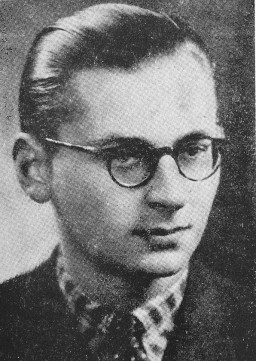
Nazi racism and racial antisemitism ultimately led to mass murder and genocide. Learn more about Nazi racial ideology.
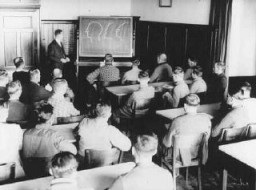
This document from the American Consul-General in Vienna certifies that the Trost family applied for American visas on September 15, 1938. It states that the family (Josef, Alice, Dorrit, and Erika) were placed on the waiting list for visas with the numbers 47291-47294.
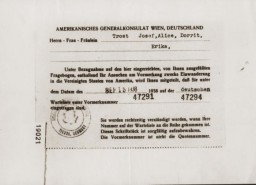
Marriage certificate obtained by Dr. Mohamed Helmy stating that Anna Gutman (Boros) married an Egyptian man in a ceremony held in Helmy’s home. Dr. Helmy also received certification from the Central Islamic Institute in Berlin attesting to Anna’s conversion to Islam, which the marriage certificate reflects. Translation: Marriage certificate On Wednesday June 16, 1943, we have certified the marriage contract between Abdelaziz Helmy Hammad, 36 years old, who was born on May 6th, 1906, in Faqous,…
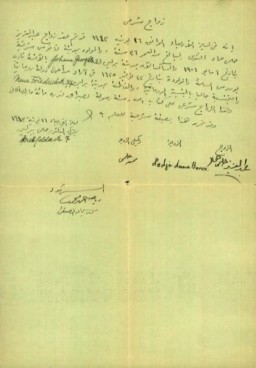
Antisemitic propaganda of an agricultural worker kicking a stereotypically depicted Jewish man through a fence. It reads "German export: Out of our German country with the slimy Jewish band."
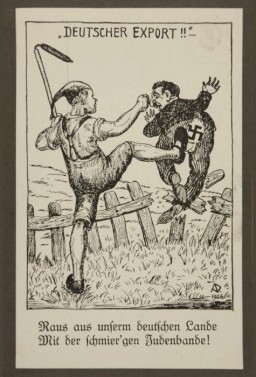
Cartoon depicting Jews, communists, and other enemies of the Nazis hanging on a gallows, 1935
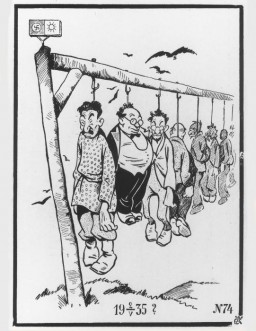
Antisemitic cartoon showing a Jew leading a Soviet official by a leash. It reads "The 'ideal' person for the chosen people: There’s no accounting for taste."
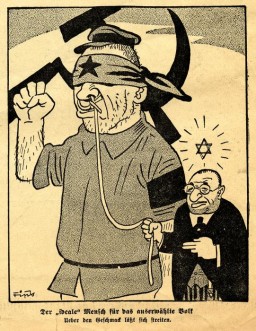
A childsize violin that belonged to Boruch Golden (Gordon), who was killed along with his mother and brother at the Ponary killing site in September 1943. Boruch was born in 1930, and was one of four children. His parents, Moshe and Basia Golden (Gordon), raised their family in Swieciany (Svencionys), Lithuania. After the German invasion of the Soviet Union in June 1941, the family was forced into the Swieciany ghetto. When that ghetto was later liquidated in 1943, the family was sent to the Vilna…
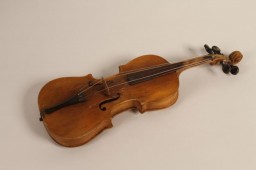
Nazi propaganda poster titled “The Stalin Constitution?” printed October 10, 1943. The Nazis often used propaganda in occupied territories to secure the compliance and even support of local populations. In Ukraine and other occupied regions of the Soviet Union, the Nazis created propaganda that exploited preexisting discontent with the Soviet regime. They also tried to exploit preexisting anti-Jewish sentiment and sharpen divisions between Jews and non-Jews. One way of achieving this was by creating…
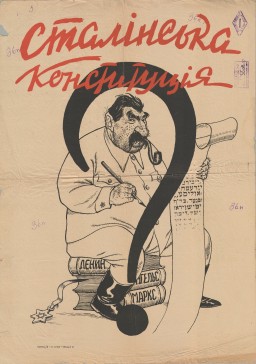
This large, lidded wooden chest was used by the Council for Aid to Jews (codenamed “Żegota”) to hide false identity documents from Nazi authorities. Żegota was an underground rescue organization of Poles and Jews in German-occupied Poland and operated from December 1942 to January 1945. Supported by the Polish government-in-exile, it coordinated efforts to save Jews in German-occupied Poland from Nazi persecution and murder. One of Żegota’s most impactful clandestine activities was producing and…
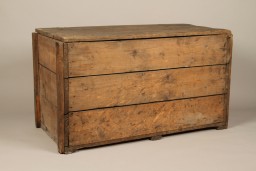
Poster titled “The United Nations Fight For Freedom.” It was one of many posters produced by the Office of War Information, the United States’s official propaganda agency during World War II. Canadian-American commercial artist Steve Broder (1902-1992) designed this work to bolster confidence in the Allied war effort against the Axis Powers (Nazi Germany, Fascist Italy, and Imperial Japan). It depicts the 30 flags of countries that signed the Declaration by the United Nations and declared war on the…
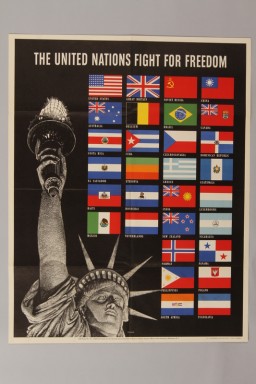
Drawing of the SS Patria, part of the illustrated diary of Egon Weiss which he compiled during and immediately after his detention in the Atlit internment camp.
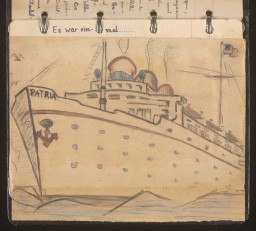
Carl Atkin was United Nations Relief and Rehabilitation Administration (UNRRA) director at the Deggendorf displaced persons camp. He received a songbook created by the survivors in his care. This page shows one of the songs compiled in the book.
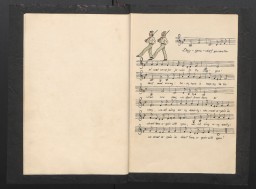
In the 25-point program, Nazi Party members publicly declared their intention to segregate Jews from "Aryan" society and to abrogate Jews' political, legal, and civil rights. Germany, 1931.
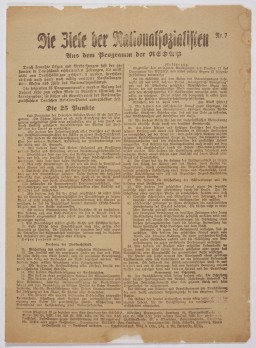
A postcard sent to Ruth Segal (Rys Berkowicz) care of the Jewish Community (JewCom) in Kobe, Japan. Family and friends in German-occupied Warsaw, Poland, sent the postcard on June 20, 1941. It bears stamps both from the Jewish council (Judenrat) in the Warsaw ghetto and from German censors. [From the USHMM special exhibition Flight and Rescue.]
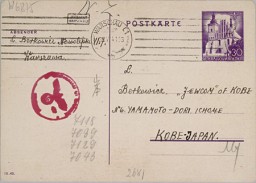
First page of a letter from a US soldier describing "the living dead" and conditions his unit encountered in a subcamp of Dachau in April 1945.
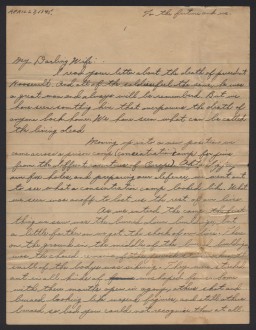
On May 25, 1939, artist Moritz Schoenberger sent this radiogram (a telegram sent by radio) from the ocean liner "St. Louis" during the voyage from Hamburg, Germany, to Havana, Cuba. On this voyage, the "St. Louis" carried over 900 Jewish refugees fleeing Nazi persecution. The telegram reads, in part, "Physically and spiritually recovered and invigorated most confident about reaching Havana Saturday. Money received. Many thanks. Kisses. Papa." Schoenberger's optimism proved unfounded. Cuban authorities…
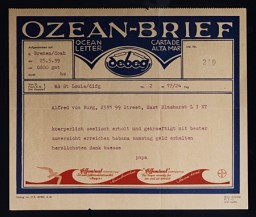
San Francisco Chronicle newspaper article titled "The Refugee Tragedy." The article was based on an interview with Moses Beckelman of the American Jewish Joint Distribution Committee, an aid organization. It discussed the overcrowding of Polish and Lithuanian refugees stranded in Shanghai, Kobe (Japan), and Lisbon (Portugal), all stops en route to North and South America. The primary cause of this bottleneck was a lack of transit and entry visas, a result of most countries closing their borders to…
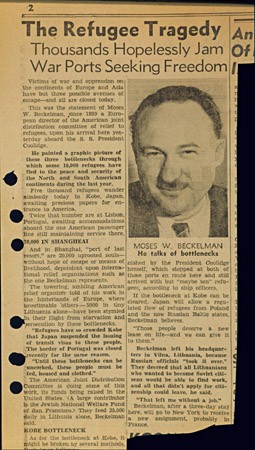
Authorities in Berlin, Germany, sent this notice to Barbara Wohlfahrt, informing her of her husband Gregor's execution on the morning of December 7, 1939. Although he was physically unfit to serve in the armed forces, the Nazis tried Wohlfahrt for his religious opposition to military service. As a Jehovah's Witness, Wohlfahrt believed that military service violated the biblical commandment not to kill. On November 8, 1939, a military court condemned Wohlfahrt to beheading, a sentence carried out one month…

The Dutch government established a camp at Westerbork to intern Jewish refugees who had entered the Netherlands illegally. This sketch of the Westerbork transit camp was made by a Jewish inmate who was able to emigrate to the United States. In early 1942, the German occupation authorities decided to enlarge Westerbork and convert it into a transit camp for Jews. The systematic concentration of Jews from the Netherlands in Westerbork began in July 1942. From Westerbork, Jews were deported to the killing…
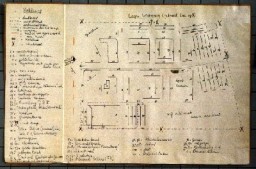
German police authorities issued this passport to Erna "Sara" Schlesinger on July 8, 1939, in Berlin. This first page of the passport illustrates the German laws that facilitated the identification of Jews in Germany. From 1938, German regulations required that Jewish women with a first name of "non-Jewish" origin use the middle name "Sara" on all official documents. Jewish men had to add the name "Israel". The letter "J" (standing for "Jude," that is, the word "Jew" in German) was stamped in red on the…
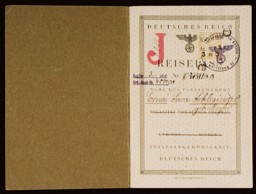
A German passport issued to Alice Mayer on February 24, 1939, in Bingen, Germany. Mayer's daughter, Ellen, is also listed on the passport. Both mother and daughter's names include the middle name "Sara." This middle name became a mandatory addition required by a law of August 17, 1938. Thereafter, all Jewish women in Germany with a first name of "non-Jewish" origin had to add "Sara" as a middle name on all official documents. Jewish men had to add the name "Israel". This enabled German officials to…
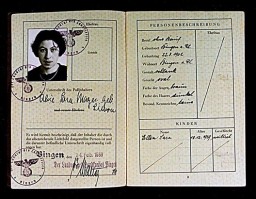
Simone Weil earned this diploma, which certified her to teach kindergarten in France, from the School of Social Work in Strasbourg in 1940. Weil assumed a false identity in late 1943 to facilitate her resistance activities as a member of the relief and rescue organization Oeuvre de Secours aux Enfants (Children's Aid Society; OSE). Among the papers documenting Weil's new identity was a forged version of this diploma bearing the name "Simone Werlin".
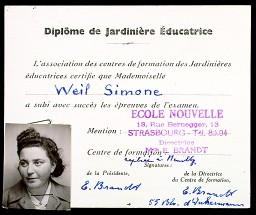
We would like to thank Crown Family Philanthropies, Abe and Ida Cooper Foundation, the Claims Conference, EVZ, and BMF for supporting the ongoing work to create content and resources for the Holocaust Encyclopedia. View the list of donor acknowledgement.